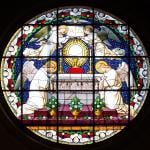So he tends to work his miracle in such a way that the one who seeks relationship with him can see his hand at work, while the one who seeks to avoid relationship with him can always chalk it up to a statistical anomaly.
A typical Vatican investigation of a miracle strikes the healthy balance between skepticism and the open-minded possibility of an actual miracle occurring. The assumption, as is normal, is that a miracle has no occurred and the normal naturalistic explanations are ticked off the list. If a naturalist explanation is found, then praise God, he worked through nature, but we are not looking at a sign that a saint has been honored by God and we move on. Catholics are free to see the hand of God at work in the occurrence, but the Church isn’t going to push to call it a miracle if natural explanations suffice.
On the other hand, sometimes miracles occur: real, bona fide, Twilight Zone stuff that can’t be explained in which you practically feel the finger of God tapping you on the shoulder and saying, “I’m still here.”
At that point, the materialist needs to figure out a way to keep the obvious at bay. One strategy is the “statistical anomaly” gambit, in which the materialist simply invokes the fact that given a large enough pool of people, a few out at the end of the statistical bell curve are going to not die in circumstances when they should be dead. The great advantage of this is that you can practice mystification with numbers and simply not look at the specific circumstances of the human person and what has occurred in his or her life. Just dissolve them in a pool of numbers and remove entirely the personal factor from the equation. Voila! No Persons, no God (who is entirely personal).
If that fails and something of the actual circumstance of the miracle threatens to penetrate the armor plating of anti-supernatural prejudice, you can always go to plan B: Denial.
So for instance, when confronted with a case like Sister Marie Simon-Pierre, who was diagnosed with Parkinson’s in 2001 and whose symptoms worsened with time until driving became practically impossible, she had difficulty walking, and her left arm hung limply at her side–and who was instantaneously heal after asking the intercession of Pope John Paul II, you can simply respond like Matthew Parris by a) linking it all to US foreign policy towards Israel; b) demanding “intelligent Christians” voice their “righteous anger” and “contempt” for this “nonsense”; c) shrieking about the “excesses of Lourdes” and of “the woeful confusion of faith with superstition”; d) declaiming “this stuff is the petrol on which the motor of a great Church runs; that without these delusions to feed on, the unthinking masses would falter”; e) fretting that it may be that the bishops of the Church are stupid enough to “honestly entertain the possibility that from beyond the grave the late Pope John Paul II interceded with God to cause a woman to be cured of Parkinson’s disease” and f) concluding this dispassionate consideration of the evidence with the following dogmatic declaration
“But how can you be sure?” Oh boy, am I sure. Oh great quivering mountains of pious mumbo-jumbo, am I sure. Oh fathomless oceans of sanctified babble, am I sure. Words cannot express my confidence in the answer to the question whether God cured a nun because she wrote a Pope’s name down. He didn’t.
And to shut down all criticism of this farrago of non sequiturs, evidence-free claims, baseless dogmatism and insults, he pre-emptively denies that he is doing what he is, in fact, doing:
Churlish nonbelievers like me are made to feel it is we who are being arrogant, dogmatic, closed-minded.
Yes. Precisely. You are arrogant, dogmatic, and close-minded, Mr. Parris. You have a theory of materialism and you are radically uninterested in considering anything inconvenient to that theory. So you dogmatically declare that it could not happen without, like, seeing if the nun was in fact inexplicably cured of Parkinson’s Disease after prayer to John Paul II.
Parris demonstrates clearly that, despite the common cultural narrative of the close-minded dogmatic religionist who fears the Light of Truth, the fact is that the atheist, when faced with stories like that of the good nun, really only has two choices: he can maintain his ignorant bigotry by simply refusing to even look at her story or he can entertain the possibility that his All Explaining Theory of Everything might have some holes in it.
Parris takes the former route, fulfilling to an exacting degree the words of the Prophet Chesterton:
The believers in miracles accept them (rightly or wrongly) because they have evidence for them. The disbelievers in miracles deny them (rightly or wrongly) because they have a doctrine against them…. It is we Christians who accept all actual evidence—it is you rationalists who refuse actual evidence being constrained to do so by your creed.











